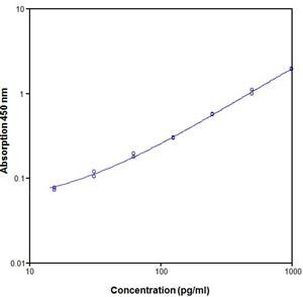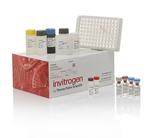Search Thermo Fisher Scientific
Product Specifications
Analytical sensitivity
Assay range
Sample type/volume
Hands-on time
Time-to-result
Homogenous (no wash)
Interassay CV
Intraassay CV
Instrument
Product size
Contents
Standard
Sample Diluent
Assay Buffer concentrate
Biotinylated Detection Antibody
SAV-HRP
Wash Buffer
Chromogen
Stop Solution
Controls
Adhesive Plate Covers
Shipping conditions
Storage
Protein name
Target sub-specificity
Species (tested)
Assay kit format
Detector antibody conjugate
Label or dye
About This Kit
The Human Soluble APO-1/Fas ELISA quantitates Hu sAPO-1/Fas in human serum, or cell culture medium. The assay will exclusively recognize both natural and recombinant Hu sAPO-1/Fas.
Principle of the method
The Human APO-1/Fas solid-phase sandwich ELISA (enzyme-linked immunosorbent assay) is designed to measure the amount of the target bound between a matched antibody pair. A target-specific antibody has been pre-coated in the wells of the supplied microplate. Samples, standards, or controls are then added into these wells and bind to the immobilized (capture) antibody. The sandwich is formed by the addition of the second (detector) antibody, a substrate solution is added that reacts with the enzyme-antibody-target complex to produce measurable signal. The intensity of this signal is directly proportional to the concentration of target present in the original specimen.
Rigorous validation
Each manufactured lot of this ELISA kit is quality tested for criteria such as sensitivity, specificity, precision, and lot-to-lot consistency. See manual for more information on validation.
FAS (Fas, CD95, APO-1) is a 46 kDa transmembrane glycoprotein that functions as a cell death receptor of the TNFR (tumor necrosis factor receptor) superfamily. FAS also exists in a soluble form that weight approximately 26kDa. Stimulation of FAS results in aggregation of its intracellular FAS-associated death domains (FADD), formation of the death-inducing signaling complex (DISC) and activation of caspases. The auto-proteolytic processing of the caspases in the complex trigger a downstream cascade that leads to apoptosis. FAS has been shown to activate NF-kappaB, MAPK3/ERK1, MAPK8/JNK, and is involved in transducing the proliferating signals in normal diploid fibroblast and T cells. At least eight alternatively spliced transcript variants encoding seven distinct isoforms have been described. The isoforms lacking the transmembrane domain may negatively regulate the apoptosis mediated by the full-length isoform. The Fas/Fas ligand system has been shown to play a role in a number of human diseases such as AIDS, hepatitis and cancer. It is also assumed that induction of apoptosis through FAS ligand pathway is predominantly involved in anti-viral immune responses.
For Research Use Only. Not for use in diagnostic procedures. Not for resale without express authorization.
Bioinformatics
Gene aliases : ALPS1A, APO-1, APT1, CD95, FAS, FAS1, FASTM, TNFRSF6
Gene ID : (Human) 355
Gene symbol : FAS
Protein Aliases : Apo-1 antigen, Apoptosis-mediating surface antigen FAS, FASLG receptor, APO-1 cell surface antigen, apoptosis antigen 1, apoptosis signaling receptor FAS, CD95, CD95 antigen, Fas (TNF receptor superfamily, member 6), Fas AMA, TNF receptor superfamily member 6, Tumor necrosis factor receptor superfamily member 6, tumor necrosis factor receptor superfamily, member 6
UniProt ID (Human) P25445

Performance Guarantee
If an Invitrogen™ antibody doesn't perform as described on our website or datasheet,we'll replace the product at no cost to you, or provide you with a credit for a future purchase.*
Learn more
We're here to help
Get expert recommendations for common problems or connect directly with an on staff expert for technical assistance related to applications, equipment and general product use.
Contact tech support


